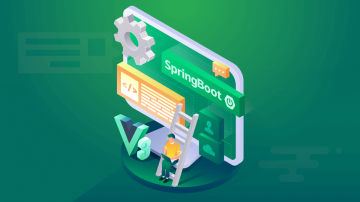本文详细介绍了SpringBoot3的核心特性,包括自动配置、独立包、外部化配置等;提供了从搭建项目到开发RESTful API的全面指南;涵盖了数据库集成与配置、项目打包与部署等内容;帮助读者快速掌握SpringBoot3资料并开发高效可靠的Web应用。
SpringBoot3资料:新手入门教程与实践指南 SpringBoot3简介SpringBoot3的核心特性
SpringBoot3是Spring框架的最新版本,它简化了Spring应用的初始搭建和开发过程。其核心特性包括:
- 自动配置:SpringBoot能够自动配置应用程序所需的bean,用户只需专注于业务逻辑。
- 独立包:SpringBoot应用可以打包为独立的可执行jar文件,内置了Tomcat、Jetty或Undertow等应用服务器。
- 外部化配置:支持将配置文件分离到独立的配置文件中,便于不同环境下的配置隔离。
- 内嵌式Web服务器:提供内嵌Web服务器的启动与停止,简化部署。
- 生产就绪功能:内置健康检查、性能指标、外部化配置等功能,无需额外的配置。
- 开箱即用:提供了大量库和框架的默认配置,能够快速启动项目。
SpringBoot3与SpringBoot2的主要区别
SpringBoot3与SpringBoot2之间的主要区别包括:
- Spring框架不同版本:
- SpringBoot3使用Spring框架5.3.x版本。
- SpringBoot2使用Spring框架5.0.x版本。
- Java版本支持:
- SpringBoot3支持Java 17。
- SpringBoot2支持Java 11。
- 项目结构:
- SpringBoot3引入了模块化开发的概念,项目结构更加清晰。
- 依赖管理:
- SpringBoot3对依赖版本的管理更加严格,确保依赖的版本兼容性。
- 性能优化:
- SpringBoot3在性能优化方面有了进一步提升,包括响应速度、资源消耗等方面。
如何快速搭建第一个SpringBoot3项目
快速搭建第一个SpringBoot3项目的步骤如下:
- 安装JDK:
- 确保安装了Java开发工具包(JDK),版本建议为Java 17。
- 安装Maven:
- 下载并配置Maven。
- 创建项目:
- 使用IDE(如IntelliJ IDEA或Spring Initializr)创建SpringBoot项目。
- 添加依赖:
- 在
pom.xml文件中添加SpringBoot依赖。
- 在
- 编写简单的控制器:
- 创建控制器类,定义HTTP请求处理方法。
- 运行项目:
- 通过IDE或命令行运行项目,访问本地服务器。
创建第一个SpringBoot3项目
- 安装JDK 17:
- 下载JDK 17安装包。
- 安装后,配置环境变量
JAVA_HOME指向JDK安装目录,设置PATH包含%JAVA_HOME%\bin。
- 安装Maven:
- 下载Maven安装包。
- 配置环境变量
MAVEN_HOME指向Maven安装目录,设置PATH包含%MAVEN_HOME%\bin。
- 创建项目:
- 使用Spring Initializr创建项目,选择Spring Boot版本为3.x。
- 在项目中添加
Spring Web依赖,用于支持Web开发。
- 添加依赖:
<dependencies> <dependency> <groupId>org.springframework.boot</groupId> <artifactId>spring-boot-starter-web</artifactId> </dependency> </dependencies> -
编写简单的控制器:
package com.example.demo.controller; import org.springframework.web.bind.annotation.GetMapping; import org.springframework.web.bind.annotation.RestController; @RestController public class HelloController { @GetMapping("/hello") public String hello() { return "Hello, SpringBoot3!"; } } - 运行项目:
- 使用IDE运行项目,或在命令行中执行
mvn spring-boot:run。 - 访问
http://localhost:8080/hello,查看返回的输出。
- 使用IDE运行项目,或在命令行中执行
下载和安装JDK
-
下载JDK:
- 访问Oracle官网下载JDK 17安装包。
- 或者从其他可靠资源下载。
-
安装JDK:
- 安装包下载后,根据提示进行安装。
- 安装完成后,配置环境变量
JAVA_HOME指向JDK的安装目录。
- 配置环境变量:
- 在系统环境变量中添加
JAVA_HOME,值设置为JDK安装目录。 - 添加
PATH环境变量,值设置为%JAVA_HOME%\bin。
- 在系统环境变量中添加
Maven的安装与配置
-
下载Maven:
- 访问Maven官网下载Maven安装包。
- 或者从其他可靠资源下载。
-
配置Maven:
- 解压下载的Maven包到指定目录。
- 在系统环境变量中添加
MAVEN_HOME,值设置为Maven包的解压目录。
- 配置环境变量:
- 在系统环境变量中添加
M2_HOME,值设置为Maven的解压目录。 - 添加
PATH环境变量,值设置为%M2_HOME%\bin。
- 在系统环境变量中添加
创建SpringBoot3项目
-
使用Spring Initializr创建项目:
- 访问https://start.spring.io/。
- 选择项目类型为Maven Project。
- 选择语言为Java。
- 选择Spring Boot版本为3.x。
- 填写项目基本信息,如组ID、模块名等。
- 点击“Generate”按钮生成项目文件。
- 导入项目到IDE:
- 下载生成的项目压缩包。
- 解压后导入到IDE中(如IntelliJ IDEA)。
添加依赖和配置文件
-
添加依赖:
- 在
pom.xml文件中添加所需的依赖。
<dependencies> <dependency> <groupId>org.springframework.boot</groupId> <artifactId>spring-boot-starter-web</artifactId> </dependency> <dependency> <groupId>org.springframework.boot</groupId> <artifactId>spring-boot-starter-data-jpa</artifactId> </dependency> <dependency> <groupId>mysql</groupId> <artifactId>mysql-connector-java</artifactId> </dependency> </dependencies> - 在
-
配置文件:
- 在
src/main/resources目录下创建application.properties或application.yml文件。
spring.datasource.url=jdbc:mysql://localhost:3306/mydb spring.datasource.username=root spring.datasource.password=root spring.jpa.hibernate.ddl-auto=update - 在
@SpringBootApplication
@SpringBootApplication是一个复合注解,包含了三个注解:
@Configuration:定义了一个配置类,可以用于注册bean、配置bean属性等。@EnableAutoConfiguration:开启自动配置功能。@ComponentScan:扫描项目中的组件(如控制器、服务、仓库等)。
示例代码:
package com.example.demo;
import org.springframework.boot.SpringApplication;
import org.springframework.boot.autoconfigure.SpringBootApplication;
@SpringBootApplication
public class DemoApplication {
public static void main(String[] args) {
SpringApplication.run(DemoApplication.class, args);
}
}@RestController, @Service, @Repository, @Component
这些注解用于定义组件类型:
@RestController:定义一个REST风格的控制器,适用于处理HTTP请求。@Service:定义一个业务逻辑组件。@Repository:定义一个数据访问层组件。@Component:定义一个通用组件。
示例代码:
package com.example.demo.controller;
import org.springframework.web.bind.annotation.GetMapping;
import org.springframework.web.bind.annotation.RestController;
@RestController
public class HelloController {
@GetMapping("/hello")
public String hello() {
return "Hello, SpringBoot3!";
}
}
package com.example.demo.service;
import org.springframework.stereotype.Service;
@Service
public class HelloService {
public String sayHello() {
return "Hello, Service!";
}
}
package com.example.demo.repository;
import org.springframework.stereotype.Repository;
@Repository
public class HelloRepository {
public String findHello() {
return "Hello, Repository!";
}
}
package com.example.demo.component;
import org.springframework.stereotype.Component;
@Component
public class HelloComponent {
public String sayHello() {
return "Hello, Component!";
}
}@Configuration, @Bean, @Profile
这些注解用于配置Spring容器:
@Configuration:标记一个类为配置类。@Bean:定义一个bean。@Profile:根据活动的profile(环境)注册bean。
示例代码:
package com.example.demo.config;
import org.springframework.context.annotation.Bean;
import org.springframework.context.annotation.Configuration;
import org.springframework.context.annotation.Profile;
@Configuration
public class AppConfig {
@Bean
@Profile("dev")
public String devConfig() {
return "Development Configuration";
}
@Bean
@Profile("prod")
public String prodConfig() {
return "Production Configuration";
}
}其他常用注解介绍
@Autowired:自动装配bean。@Value:注入属性值。@RequestMapping:映射URL到控制器方法。@Transactional:声明式事务管理。
示例代码:
package com.example.demo.service;
import org.springframework.beans.factory.annotation.Autowired;
import org.springframework.stereotype.Service;
@Service
public class HelloService {
@Autowired
private HelloRepository repository;
public String sayHello() {
return repository.findHello();
}
}
package com.example.demo.controller;
import org.springframework.beans.factory.annotation.Value;
import org.springframework.web.bind.annotation.GetMapping;
import org.springframework.web.bind.annotation.RestController;
@RestController
public class HelloController {
@Value("${example.value}")
private String exampleValue;
@GetMapping("/hello")
public String hello() {
return "Hello, " + exampleValue;
}
}创建RESTful服务端点
创建RESTful服务端点,定义HTTP请求处理方法。
示例代码:
package com.example.demo.controller;
import org.springframework.web.bind.annotation.GetMapping;
import org.springframework.web.bind.annotation.RestController;
@RestController
public class HelloController {
@GetMapping("/hello")
public String hello() {
return "Hello, SpringBoot3!";
}
}使用@ControllerAdvice进行全局异常处理
使用@ControllerAdvice定义全局异常处理器。
示例代码:
package com.example.demo.controller;
import org.springframework.http.HttpStatus;
import org.springframework.http.ResponseEntity;
import org.springframework.web.bind.annotation.ControllerAdvice;
import org.springframework.web.bind.annotation.ExceptionHandler;
import org.springframework.web.bind.annotation.ResponseBody;
@ControllerAdvice
public class GlobalExceptionHandler {
@ExceptionHandler(Exception.class)
@ResponseBody
public ResponseEntity<String> handleException(Exception ex) {
return new ResponseEntity<>("An error occurred: " + ex.getMessage(), HttpStatus.INTERNAL_SERVER_ERROR);
}
}实现分页和排序功能
使用Spring Data JPA实现分页和排序功能。
示例代码:
package com.example.demo.repository;
import org.springframework.data.domain.Page;
import org.springframework.data.domain.Pageable;
import org.springframework.data.jpa.repository.JpaRepository;
import org.springframework.stereotype.Repository;
@Repository
public interface HelloRepository extends JpaRepository<HelloEntity, Long> {
Page<HelloEntity> findAll(Pageable pageable);
}使用Spring Data JPA进行CRUD操作
定义实体类和仓库接口,实现CRUD操作。
示例代码:
package com.example.demo.entity;
import javax.persistence.Entity;
import javax.persistence.GeneratedValue;
import javax.persistence.GenerationType;
import javax.persistence.Id;
@Entity
public class HelloEntity {
@Id
@GeneratedValue(strategy = GenerationType.IDENTITY)
private Long id;
private String message;
// Getter and Setter methods
}package com.example.demo.repository;
import org.springframework.data.jpa.repository.JpaRepository;
@Repository
public interface HelloRepository extends JpaRepository<HelloEntity, Long> {
}package com.example.demo.service;
import com.example.demo.entity.HelloEntity;
import com.example.demo.repository.HelloRepository;
import org.springframework.beans.factory.annotation.Autowired;
import org.springframework.stereotype.Service;
import java.util.List;
@Service
public class HelloService {
@Autowired
private HelloRepository repository;
public List<HelloEntity> findAll() {
return repository.findAll();
}
}使用SpringBoot3连接MySQL数据库
配置连接MySQL数据库。
示例代码:
spring.datasource.url=jdbc:mysql://localhost:3306/mydb
spring.datasource.username=root
spring.datasource.password=root
spring.jpa.hibernate.ddl-auto=update使用Spring Data JPA进行数据库操作
定义实体类和仓库接口,实现数据库操作。
示例代码:
package com.example.demo.entity;
import javax.persistence.Entity;
import javax.persistence.GeneratedValue;
import javax.persistence.GenerationType;
import javax.persistence.Id;
@Entity
public class HelloEntity {
@Id
@GeneratedValue(strategy = GenerationType.IDENTITY)
private Long id;
private String message;
// Getter and Setter methods
}package com.example.demo.repository;
import org.springframework.data.jpa.repository.JpaRepository;
@Repository
public interface HelloRepository extends JpaRepository<HelloEntity, Long> {
}package com.example.demo.service;
import com.example.demo.entity.HelloEntity;
import com.example.demo.repository.HelloRepository;
import org.springframework.beans.factory.annotation.Autowired;
import org.springframework.stereotype.Service;
import java.util.List;
@Service
public class HelloService {
@Autowired
private HelloRepository repository;
public List<HelloEntity> findAll() {
return repository.findAll();
}
}配置多数据源
配置多个数据源,支持多数据库操作。
示例代码:
spring.datasource.primary.url=jdbc:mysql://localhost:3306/mydb1
spring.datasource.primary.username=root
spring.datasource.primary.password=root
spring.datasource.secondary.url=jdbc:mysql://localhost:3306/mydb2
spring.datasource.secondary.username=root
spring.datasource.secondary.password=rootpackage com.example.demo.repository;
import org.springframework.jdbc.core.JdbcTemplate;
import org.springframework.stereotype.Repository;
@Repository
public class SecondaryRepository {
private JdbcTemplate jdbcTemplate;
public SecondaryRepository(JdbcTemplate jdbcTemplate) {
this.jdbcTemplate = jdbcTemplate;
}
public String findHello() {
return jdbcTemplate.queryForObject("SELECT message FROM hello", String.class);
}
}实现事务管理
使用@Transactional注解实现事务管理。
示例代码:
package com.example.demo.service;
import com.example.demo.entity.HelloEntity;
import com.example.demo.repository.HelloRepository;
import org.springframework.beans.factory.annotation.Autowired;
import org.springframework.stereotype.Service;
import org.springframework.transaction.annotation.Transactional;
@Service
public class HelloService {
@Autowired
private HelloRepository repository;
@Transactional
public void saveHello(HelloEntity entity) {
repository.save(entity);
}
}使用Maven打包项目
使用Maven打包项目,生成可执行的jar文件。
<build>
<plugins>
<plugin>
<groupId>org.springframework.boot</groupId>
<artifactId>spring-boot-maven-plugin</artifactId>
</plugin>
</plugins>
</build>命令行打包:
mvn clean install部署到本地Tomcat服务器
将打包好的jar文件部署到本地Tomcat服务器。
java -jar target/myproject.jar部署到远程服务器
将打包好的jar文件上传到远程服务器,并启动。
scp target/myproject.jar user@remotehost:/path/to/deploy
ssh user@remotehost
java -jar /path/to/deploy/myproject.jar使用Docker容器化部署
使用Docker进行项目容器化部署。
FROM openjdk:17-jdk-alpine
COPY target/myproject.jar app.jar
ENTRYPOINT ["java", "-jar", "/app.jar"]构建并运行Docker镜像:
docker build -t myproject .
docker run -p 8080:8080 myproject总结:
本文详细介绍了SpringBoot3的核心特性、搭建项目、常用注解、RESTful API开发、数据库集成与配置、项目打包与部署等内容。通过本文的学习,读者可以快速上手SpringBoot3,开发高效、可靠的Web应用。

 随时随地看视频
随时随地看视频




